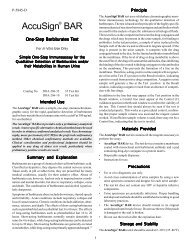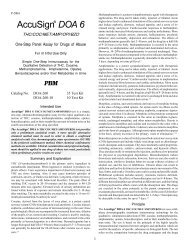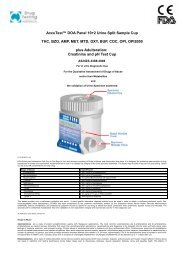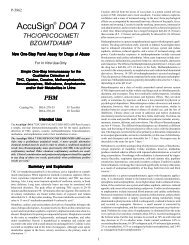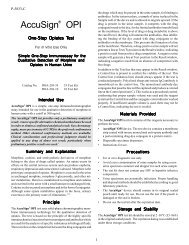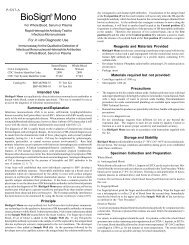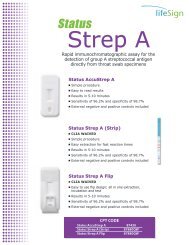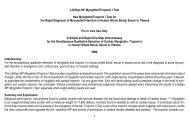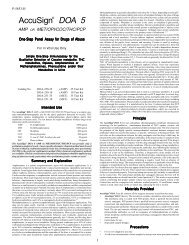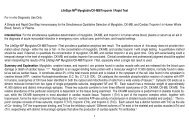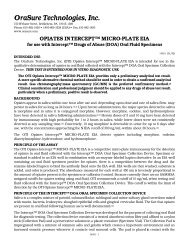AccuTest DOA Panel 9+2 Urine Split Sample Cup - Drug Testing
AccuTest DOA Panel 9+2 Urine Split Sample Cup - Drug Testing
AccuTest DOA Panel 9+2 Urine Split Sample Cup - Drug Testing
You also want an ePaper? Increase the reach of your titles
YUMPU automatically turns print PDFs into web optimized ePapers that Google loves.
STORAGE AND STABILITY<br />
The test device should be stored at 2 to 30 o C and will be effective until the expiration date stated on the package. The product is humidity-sensitive and should be used immediately<br />
after being open. Any improperly sealed product should be discarded.<br />
PRECAUTIONS<br />
1. For in vitro diagnostic and forensic use only. <strong>Urine</strong>Check is ONLY for validating the integrity of urine specimen and MUST not be used for diagnostic use.<br />
2. Do not use the product beyond the expiration date.<br />
3. Handle all specimens as potentially infectious.<br />
4. Humidity sensitive product. Do not open foil pouch until it is ready to be tested.<br />
5. Use a new urine specimen cup for each sample to avoid cross contamination.<br />
SPECIMEN COLLECTION AND PREPARATION<br />
Fresh urine does not require any special handling or pretreatment. Specimen should be collected in a clean, dry, plastic or glass container. If the assay is not performed immediately,<br />
urine specimen may be refrigerated at 2-8°C or froz en up to 7 days. Specimens should be brought to room temperature before testing. <strong>Urine</strong> specimens shall not be centrifuged nor<br />
added preservatives. Commercially available controls that contain sodium azide or other preservatives that will inhibit the enzyme activity may results in failure of Alcohol and<br />
<strong>Urine</strong>Check test(s). Avoid contact with skin by wearing gloves and proper laboratory attire.<br />
QUALITY CONTROL<br />
Good Laboratory practice recommends the daily use of control materials to validate the reliability of device. Control materials should be assayed as clinical specimen and<br />
challenging to the assay cutoff concentration, e.g., 25% above and below cutoff concentration. If control values do not fall within establish range, assay results are invalid. Control<br />
materials which are not provided with this test kit are commercially available.<br />
<strong>Drug</strong>s of Abuse<br />
<strong>DOA</strong> <strong>Panel</strong> Test provides a built-in process control with a different antigen/antibody reaction at the control region (C) in <strong>Drug</strong>s of Abuse Tests. This control line should always<br />
appear regardless the presence of drug or metabolite. If the control line does not appear, the test device should be discarded and the obtained result is invalid. The presence of<br />
this control band in the control region serve as 1) verification that sufficient volume is added, 2) that proper flow is obtained.<br />
Adulteration Test<br />
For best results, performance of Adulteration test should be confirmed by testing known negative and positive specimens or controls whenever a new test is performed or<br />
whenever a new bottle is first opened.<br />
PROCEDURE<br />
1. Bring test devices and specimens to the room temperature (15-28ºC) if they have been refrigerated.<br />
2. Remove the urine test cup from the sealed foil pouch.<br />
3. Remove the lid and collect the sample, ensuring that the sample is above the minimum fill line.<br />
4. Secure the lid tightly and place the urine test cup on a flat surface.<br />
5. Remove key from lid and insert in the side chamber, push to release the sample into the test zone.<br />
6. At 5 minutes, remove the result window cover and observe the results.<br />
Do not interpret the results after 10 minutes.



